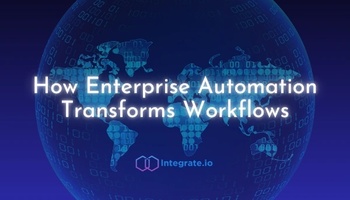In today's increasingly data-driven world, automation is a crucial skill for any professional. Data professionals can automate repetitive tasks and free up their time to focus on more valuable work. This article will discuss the four most common data automation techniques you can utilize in your own business and the automation tools that help your ETL process.
Data Preparation
Data preparation is the process of identifying and validating data quality. The primary purpose of data preparation is to identify all errors, inconsistencies, and redundancies in your dataset before continuing with any analysis on it. This step can be time-consuming, but it will save you a lot more time later if done correctly from the start rather than having to go back and fix these mistakes after they have been identified.
Why Is Data Preparation Essential?
Data preparation is essential for many reasons.
First, you want to avoid spending time on data analysis only to find that your dataset has errors or inconsistencies.
Second, this step will help with accurate results during further analysis by ensuring all relevant information is included and removing anything unnecessary (such as duplicates).
Third, this stage prepares data so it is readable by relational databases and helps the initial stages of process automation.
Data Preparation Best Practices
The best way to prepare your data is by utilizing a systematic process. This process includes:
- Gain a thorough understanding of how the dataset was collected and why it is being used for this project before cleaning up any issues.
- Identify what kind of information within the dataset needs to be cleaned up. Also, identify which type of data errors need to be removed from each column or row. Some common examples include incorrectly spelled words that can easily be corrected via spell checkers or incorrect phone numbers formatted incorrectly.
- Decide on the order of operation for cleaning up your data based on the most time-consuming or error-prone tasks.
Data Transformation
Data transformation is the process of transforming your dataset into an analyzable form so that you can use it for analysis. Data transformation often involves wrangling or cleaning up data and combining datasets.
Why Is Data transformation Significant?
Data transformation is essential because you want to analyze your data in the most helpful way possible. Using statistical modeling or other approaches that allow for more flexible analysis options than just rigidly applying formulas, you can accomplish this.
If you are working with big data and large datasets, transforming them into a single table before beginning any analysis will save you time and effort later on when it comes time to perform calculations during your actual analysis process.
Data Transformation Best Practices
There are many different ways you can transform your dataset into something more useful for analysis. Still, the most important thing to keep in mind here is that this should always be done via a systematic process where any changes made to one table will affect all other tables because they were derived from these original tables.
Decide on the order of operation for data transformation based on the most time-consuming or error-prone tasks first to ensure that you are constantly making progress throughout this process. This includes:
- Identifying what information within the dataset needs to be transformed to better fit whatever analytical approach has been planned out already. For example, if there are two separate datasets containing customer demographics and purchase behaviors respectively, then transforming both of these would mean matching up variables such as age or income level so that they can be analyzed together.
Data Loading
Loading is the data process of putting your clean, transformed dataset into a data warehouse that can be easily accessed when necessary. Data loading allows you to work with large datasets outside of memory on your local machine without manually transferring it back and forth every time an analysis needs to be run.
Why Is Data loading Significant?
Data loading is essential because it allows you to scale up your analysis capabilities by freeing more of the computer's memory, making it easier for computationally intensive data mining algorithms or analyses that require extensive processing times.
Once your data has been transformed, you can load it up in a database management system so that when necessary, queries or other tasks can efficiently be run on this dataset without having to re-load all of these records into memory. This also allows more than just one person to access and use this particular data set. This streamlines real-time collaboration and speeds up business processes.
Data Loading Best Practices
When it comes to data loading, there are a few best practices that you should adhere to here:
- Loading the minimum amount of records necessary for your analysis. If you have 100,000 customer demographics and purchase behaviors but only need five different variables from each dataset, then load just those five into memory instead of all 100,000, which will save processing time.
- Whenever possible, avoid creating new columns within your data during this process because these must also be loaded into memory. Instead, create an index or lookup table that contains every variable used throughout this entire analysis. When queries are run against this database, they can return results based on whatever subset of information is requested rather than load all of the data into memory first for this.
Data Analysis and Visualization
Data analysis and visualization take your transformed dataset and run statistical tests to find relationships, patterns, or trends in the data. Data analysts will often visualize the results of their analyses to share them with colleagues, customers, or other interested parties.
Why Is Data Analysis and Visualization Important?
Data analysis is essential because it allows you to perform data capturing and gain business intelligence from what might otherwise be just a bunch of numbers without making any sense out of them. Without performing this step, all your efforts at data transformation and data extraction would be wasted. There wouldn't be anything exciting or valuable about the final results if they didn't answer some question that was posed before beginning this process.
Visualizing information can simplify and improve the decision-making process by bringing clear, new perspectives to business users. It enables data scientists and analysts to see information in entirely different contexts.
Best Practices for Data Analysis and Visualization
Some of the best practices for data analysis and visualization include:
- To get the most out of your analysis, ensure that you explore as much data as possible. In other words, try not to limit yourself by focusing on a particular subset or slice of this dataset unless there is some specific reason for doing so.
- Use both univariate and multivariate statistical tests in tandem whenever possible because they will often give you complimentary insights into what is happening within the big data. This also ensures that any findings derived from one kind of test can be independently verified using another method.
- Visualizing the data in different ways will help you find new and unexpected relationships between variables or formats that might not be as immediately obvious when only using one visualization method (such as a line chart or bar graph). Try creating histograms, scatterplots, box plots, and other kinds of charts whenever possible since they can provide valuable insights about your dataset which no other single type of visual representation could capture on its own.
How Integrate.io Can Help with Data Science
Integrate.io's cloud-based data automation service allows you to build, transform and deploy high-quality datasets in a fraction of the time it would take using traditional workflows like manual data entry. Once your aggregate data is accessible to our platform, you can begin building queries against this information through an easy-to-use web dashboard. This data integration will allow you to perform complex transformations on large amounts of raw data without prior coding or technical skills.
Our platform will prep your data for analysis and visualization. Having all of your data sources aggregated into one place can also help you identify opportunities for future data collection that might not have been apparent until after taking a closer look at this information.
If your business is looking to learn more about how to increase workflow automation with data pipelines, and automate data collection, schedule a demo with the Integrate.io API platform by clicking the link here.







